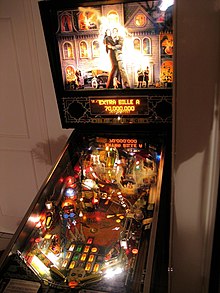Williams was one of the major forces in arcade amusement history. Taking note of Atari’s success with Pong in 1973, Williams decided to enter the fledgling coin-operated arcade videogame industry. Its first arcade videogame was Paddle-Ball.[9] In 1974, Williams Electronics, Inc. was formed to acquire the company. Williams developed its own breakthrough hit with the release of 1980’s Defender, whose space alien theme and scrolling feature made it an instant classic. Williams’ other notable arcade hits were 1982’s Joust and Robotron: 2084. In 1980, Seeburg (which had since been renamed XCOR International) sold Williams to Louis Nicastro, who, with his son Neil, would take the company public and run it for over two decades.
At the same time, Williams entered the solid-state electronic pinball market and would come to dominate the pinball industry. Williams’ first solid-state machines produced in 1976 were prototype runs based on electromechanical games; Aztec (1976)[10] and Grand Prix.[11] Williams continued to release new electromechanical pinball machines through October 1977, when they released their last, Wild Card.[12] From November 1977, Williams released solid-state pinball games exclusively, beginning with their first solid state production model Hot Tip (1977),[13] which sold 4,903 units (the electromechanical version previously released in June sold 1,300 units).[14] From the late 1970s through the 1980s, Williams released numerous innovative pinball games, such as Gorgar (1979, the first pinball featuring a synthetic voice), Firepower (1980), Black Knight (1980), Space Shuttle (1984), Comet (1985), Pin*Bot (1986), F-14 Tomcat (1987) and Cyclone (1988).

Addams Family pinball game
By 1983, the arcade amusement industry experienced a major decline. Williams managed to weather the poor economic conditions better than most. In 1985, Williams once again changed its name, this time to Williams Electronics Games, Inc. It became a publicly traded company in 1987, and the parent company’s name became WMS Industries, Inc. trading on the New York Stock Exchangeunder the ticker symbol WMS. In 1988, WMS acquired Bally Midway Manufacturing Company, which was the result of a 1982 merger between Bally‘s pinball division and Bally’s video game company Midway Manufacturing. For over a decade, the company was known in the industry as Williams-Bally-Midway. Williams also continued to sell pinball machines (under the Williams and Bally brand names), while Midway concentrated on video games (thus ending the Williams brand in video games in 1991). WMS created a new division in 1991, Williams Gaming (now WMS Gaming), to enter the gaming and state video lottery markets, developing its first video lottery terminals for the Oregon market in 1992.
In 1992, the company produced the licensed Addams Family pinball game based on the 1991 Addams Family movie. Addams Familysold 20,270 units, a record that still stands today. In 1993, the company produced Twilight Zone which sold an impressive 15,235 units, but the pinball and arcade game industries continued to decline. After 1993, though still the market leader, Williams never came close to matching the sales numbers of Twilight Zone and Addams Family. In 1999, Williams made one last attempt to revitalize pinball sales with its Pinball 2000 machines that integrated pinball with computer graphics on embedded raster-scan displays. The innovation didn’t pay off, as the manufacturing expenses exceeded the prices that the market would bear, and that same year, WMS left the pinball industry to focus on slot machine development.[15] Over the years, however, the company produced an extensive list of video games.
During the “Golden Age” of pinball, Williams was one of the three major manufacturers (Bally and Gottlieb being the other two). For much of the later history of pinball, Williams dominated the industry even as pinball declined in popularity. In 2005, Pinball News.com reported that WMS had exclusively licensed the intellectual properties and the rights to re-manufacture former Bally/Williams games in the field of mechanical pinball (including traditional pinball and Pinball 2000-style machines) to Australian Wayne Gillard of The Pinball Factory.
Source: WikiPedia

